Solace, Arista and NetEffect Demonstrate Market Data Performance Gain
Ottawa, Canada, November 11, 2008 – Solace Systems, the leading supplier of high-speed, low-latency content networking systems, today announced a collaboration with Arista Networks and NetEffect, an Intel company, to demonstrate how specialty hardware platforms can optimize both the peak performance and consistency of ultra-low latency data delivery under the most demanding conditions.
Using Arista Networks low latency switching technology in 1GigE mode, NetEffect Gigabit Ethernet adapters on client computers and a Solace Systems 3260 Content Router for ultra-low latency messaging, tests measured end-to-end market data delivery from the publishing feed infrastructure routed to the appropriate receiving applications. Tests used 100 byte messages at rates of 500, 000 messages per second to simulate peak US market data rates for all equities, commodities and FX instruments. Testing resulted in an average latency of 31 microseconds and a 99.9th percentile latency of 47 microseconds with a standard deviation of just 6 microseconds. A second test with 100 byte messages at 1, 000, 000 messages per second was run to simulate rates greater than peak OPRA market data activity. This yielded an average latency of 35 microseconds and a 99.9th percentile latency of 55 microseconds, with a standard deviation of 7 microseconds. The combination of these three technologies demonstrated that tens to hundreds of microseconds can be removed from high-volume market data configurations when compared with standard software and Ethernet switching technology.
In financial services, low latency translates directly to greater profits as firms race to feed their algorithmic trading infrastructures with more and more market data. As a result, firms are increasingly looking to replace strained legacy software infrastructure with purpose-built hardware to route, filter and accelerate messaging thus improving trading results.
“Executing the network stacks and messaging functionality in hardware makes a world of difference in the throughput, latency reduction, predictability and elimination of outliers, ” said Ralph Frankel, Solace’s chief technology officer. “Specialty hardware is a hot topic on Wall Street specifically because it offers tangible benefits in terms of speed and ROI, especially in algorithmic trading environments.”
All testing was completed in a configuration common to any production customer environment: one Solace 3260 Content Router, one Arista Networks 7124S Ethernet Switch in 1GigE mode and one NetEffect Gigabit Ethernet adapter per client. Financial firms with ultra-low latency requirements should expect to obtain very similar results in their own networks using this configuration. The test criteria were chosen to represent common, real world configurations and do not represent the maximum capabilities of each product. For example, in a two blade configuration, a Solace content router can handle 10 million messages per second (5 million in and 5 million out).
Ultra-low latency trading architects view latency consistency as just as important as absolute values. Most messaging benchmarks only quote minimum or median results, but fail to mention that results at the upper extremes are unacceptably high. The results published here include both the 99.9th percentile data and standard deviation results that affirm the narrow latency bounds of hardware messaging and network acceleration.
“Arista Networks’ switches support both one and 10 Gigabit Ethernet modes on each and every port offering the lowest latency in the market, ” said Mansour Karam, director of marketing and business development at Arista Networks. “By replacing classical one Gigabit Ethernet technology with Arista 7100 series, customers will save tens of microseconds and ensure consistent ultra-low latency across the market data delivery applications.”
For more information including office locations and contact details, please visit solace.com or www.aristanetworks.com.
###

